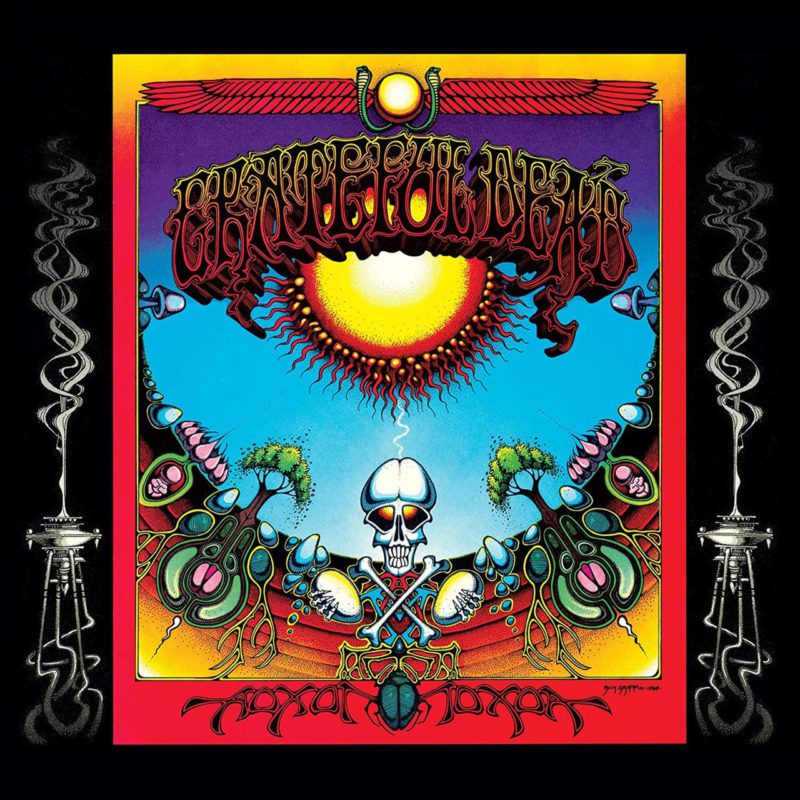The Psych Ward–Aoxomoxoa by the Grateful Dead
The Psych Ward–Aoxomoxoa by the Grateful Dead
Aoxomoxoa is the third studio album released by The Grateful Dead, one of the most iconic bands of all time. Released in June 1969, Aoxomoxoa was one of the first rock albums to be recorded using 16-track technology. The band was gleefully at the controls as they produced the effort with their own engineers, tellingly including LSD chemist Owsley Stanley.
“St. Stephen” starts the album merrily with an irreverent rocker about the Christian martyr. Its lulled, xylophone-tinged bridge surrenders to a raucous staccato jam that bookends the last verse of this fan-favorite.
Aoxomoxoa is a wayfaring oddity and snapshot that best encapsulates the Grateful Dead’s 1960s era of mind-bending vagabondage.
“Dupree’s Diamond Blues” is a cautionary tale of a lovesick loser sentenced to life for killing the proprietor of the jewelry store he robbed to buy his lady a diamond ring. Tom Constanten provides colorful rotary organ on this ditty which is not so much blues as off-beat gypsy rock.
“Rosemary” is a forgotten acoustic interlude most notable for its use of a rotating Leslie speaker to modulate vocalist/guitarist Jerry Garcia’s voice, a revolutionary technique the group first utilized in their 1968 release Anthem of the Sun.
“Doin’ That Rag” is a quirky oddball that is middling despite its catchy concluding riff. Still developing his rhapsodic craft, the band’s prolific poet Robert Hunter dabbles in lyrical themes of riverside jaunts and gambling games which are better elucidated in their twin releases that followed in 1970.
“Mountains of the Moon” is a Baroque-tinged cosmic canticle that is pleasantly supplanted by harpsichord and acoustic guitar. Like several of the album’s tracks, this fleeting song didn’t survive past the 60s in the band’s live repertoire.
“China Cat Sunflower” is represented here as a whimsical, arrhythmic jingle, punctuated by Garcia’s frantic guitar lead and Hunter’s illustrative lyrics. The studio production elicits a more alchemistic “China Cat” than the bouncy romp it developed into when inextricably paired live with “I Know You Rider.” This Deadhead favorite is the album’s only song to be featured in the band’s setlists in every era.
“What’s Become of the Baby” is a spooky, acid-soaked elegy, solely featuring Garcia’s heavily-modulated voice accompanied only by the occasional ambient cymbal.
“Cosmic Charlie” swaggers with an infectious slow groove, accented by tasty pedal steel. The dynamics rise and fall effectively before bringing the well-varied album to a satisfying close.
Aoxomoxoa is a wayfaring oddity and snapshot that best encapsulates the Grateful Dead’s 1960s era of mind-bending vagabondage. While expanding their minds with psychedelics, the band further explored stellar horizons and new instrumental frontiers, before transitioning towards acoustic Americana the following year. A rare gem!
Related: The 100 Best Psychedelic Rock Albums of the Golden Age
The Top 200 Psychedelic Songs from the Original Psychedelic Era
The Top 100 Rock Artists of All Time
The Psych Ward: Anthem of the Sun by the Grateful Dead
Concert Review–Dead & Company at Riverbend Music Center
Gallery
Recent Articles
2025 Year In Review
•
December 31, 2025

Loading...
A Tale of Crescendo ~ Chapter 5: The War Begins; Chapter 6: The Great Hall
- Bill Kurzenberger
Jorma Kaukonen 85th Birthday Celebration in San Francisco – Concert Review
- Kyle Siegrist
A Tale of Crescendo ~ Chapter 3: The West & The East; Chapter 4: The First Crescendo
- Bill Kurzenberger




1 thought on “The Psych Ward–Aoxomoxoa by the Grateful Dead”
In the original album release, What’s Become of the Baby was full of weird, spooky, and sometimes jarring sound effects. I was surprised to find, after buying a replacement version of the album, that the song was quite different. The recent 50th anniversary CD version has both versions of the album – with some other changes as well.